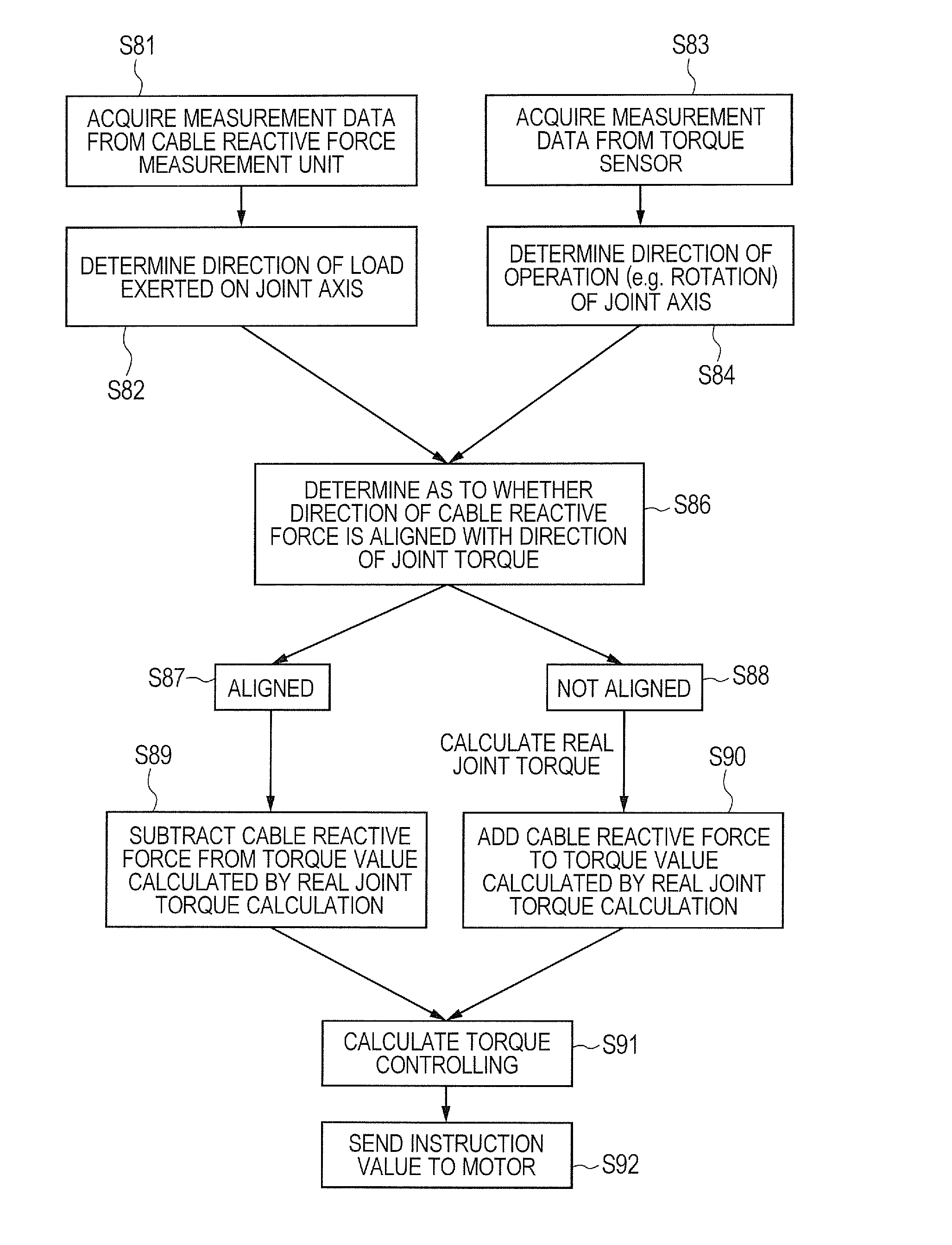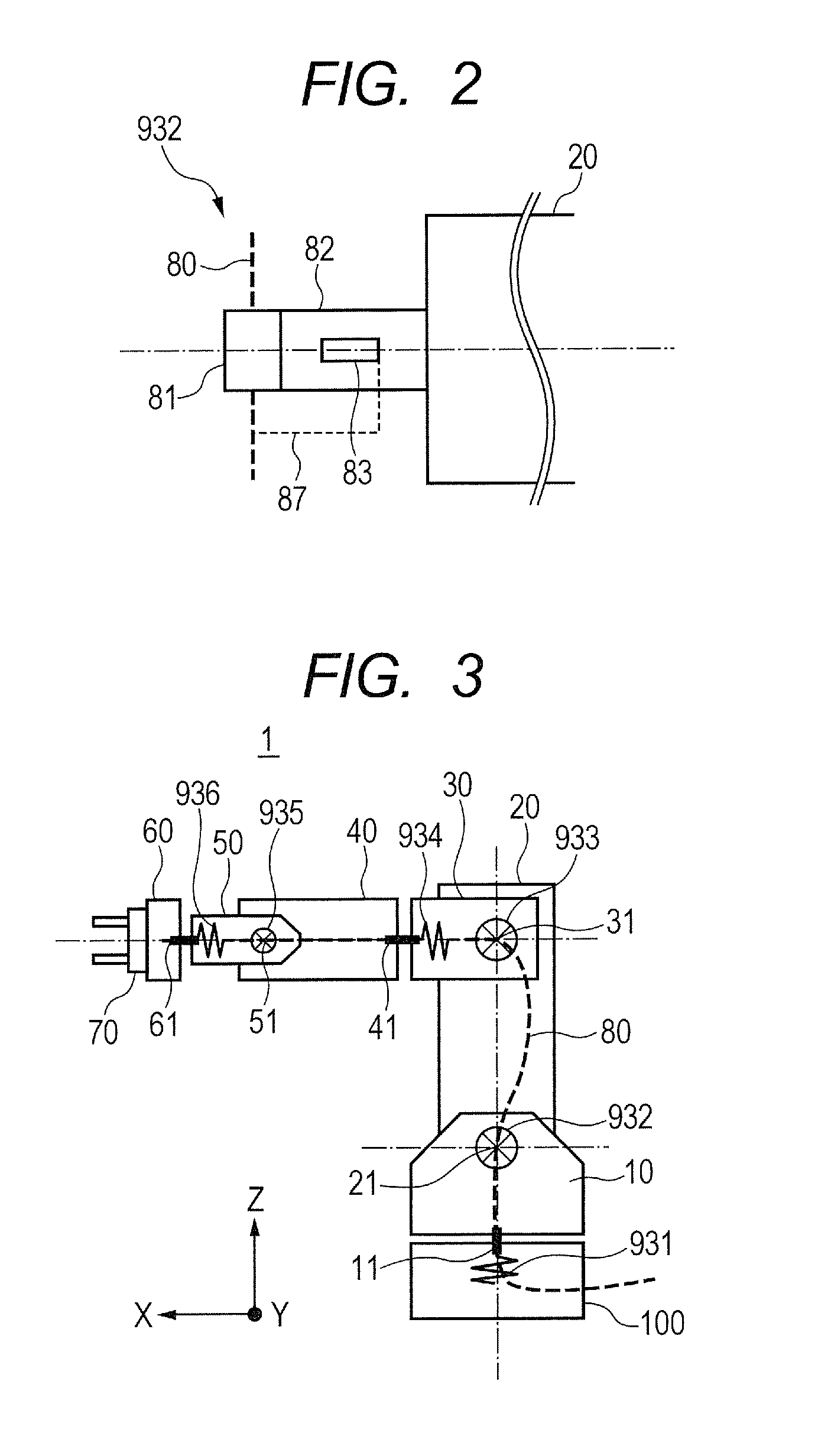Robot apparatus and method for controlling robot apparatus
a robot and robot technology, applied in the field of robot apparatus, can solve the problems of inability to achieve a sufficient precision range, the reactive force becomes an extremely large disturbance, and the member cannot, and achieve the effect of high precision, high precision and light weigh
- Summary
- Abstract
- Description
- Claims
- Application Information
AI Technical Summary
Benefits of technology
Problems solved by technology
Method used
Image
Examples
exemplary embodiment 1
[0032](Basic Structure of Robot Apparatus)
[0033]FIG. 1A and FIG. 1B are views illustrating a whole structure of a multi-joint robot apparatus, as one example of a robot apparatus which has adopted the present invention. FIG. 1A is a view illustrating the robot apparatus of the present exemplary embodiment which is viewed, for instance, from a side face. FIG. 1A illustrates coordinates of a three-dimensional (XYZ) coordinate system which is used for control of this robot apparatus, in the lower left part thereof. As is illustrated in FIG. 1A, a Z-axis among these coordinates is arranged so as to point upward in FIG. 1A, and an X-axis is arranged so as to point the left direction in FIG. 1A. FIG. 1B is a view illustrating a robot arm 1 of the robot apparatus of the present exemplary embodiment, which is viewed, for instance, from the rear part (left part in FIG. 1A). FIG. 1B illustrates also similar coordinates of the three-dimensional (XYZ) coordinate system, in the lower right part ...
exemplary embodiment 2
[0098]As for the cable reactive force measuring unit which is arranged on the rotational joint of the robot arm 1, a different structure is considered. Also in the present exemplary embodiment, the configuration of the control system of the robot apparatus shall be similar to that illustrated in FIG. 4 and FIG. 9 in the above-described Exemplary Embodiment 1. In addition, in the present exemplary embodiment and an exemplary embodiment which will be described later, the members which are same as or equivalent to those in the above-described Exemplary Embodiment 1 are designated by the same (or similar) reference characteristics below, and the detailed description will be omitted.
[0099](Arrangement of Force Sensor)
[0100]FIG. 5 illustrates the structure of the robot arm 1, and the cable reactive force measuring units 931 to 936 which are arranged on the respective rotational joints 11, 21, 31, 41, 51 and 61, in the present exemplary embodiment.
[0101]In the present exemplary embodiment,...
exemplary embodiment 3
[0115]In the present exemplary embodiment, some examples of a robot control procedure (robot control program) are illustrated which can be executed by the CPU 601 of the above-described controlling apparatus 91. FIG. 7 and FIG. 8 illustrate a flow of the robot control procedure (robot control program) which can be executed by the CPU 601 of the controlling apparatus 91. A control example in FIG. 7 is an example of correcting instruction values for driving the rotational joints sent from the instruction apparatus 94, according to the cable reactive forces which have been measured by the cable reactive force measuring units 931, 932, 933, 934, 935 and 936. In addition, the control example in FIG. 8 is an example of correcting the torque control which feeds back the output values of the torque sensors 12, 22, 32, 42, 52 and 62, according to the cable reactive forces which have been measured by the cable reactive force measuring units 931, 932, 933, 934, 935 and 936. The controls in FIG...
PUM
 Login to View More
Login to View More Abstract
Description
Claims
Application Information
 Login to View More
Login to View More - R&D
- Intellectual Property
- Life Sciences
- Materials
- Tech Scout
- Unparalleled Data Quality
- Higher Quality Content
- 60% Fewer Hallucinations
Browse by: Latest US Patents, China's latest patents, Technical Efficacy Thesaurus, Application Domain, Technology Topic, Popular Technical Reports.
© 2025 PatSnap. All rights reserved.Legal|Privacy policy|Modern Slavery Act Transparency Statement|Sitemap|About US| Contact US: help@patsnap.com



